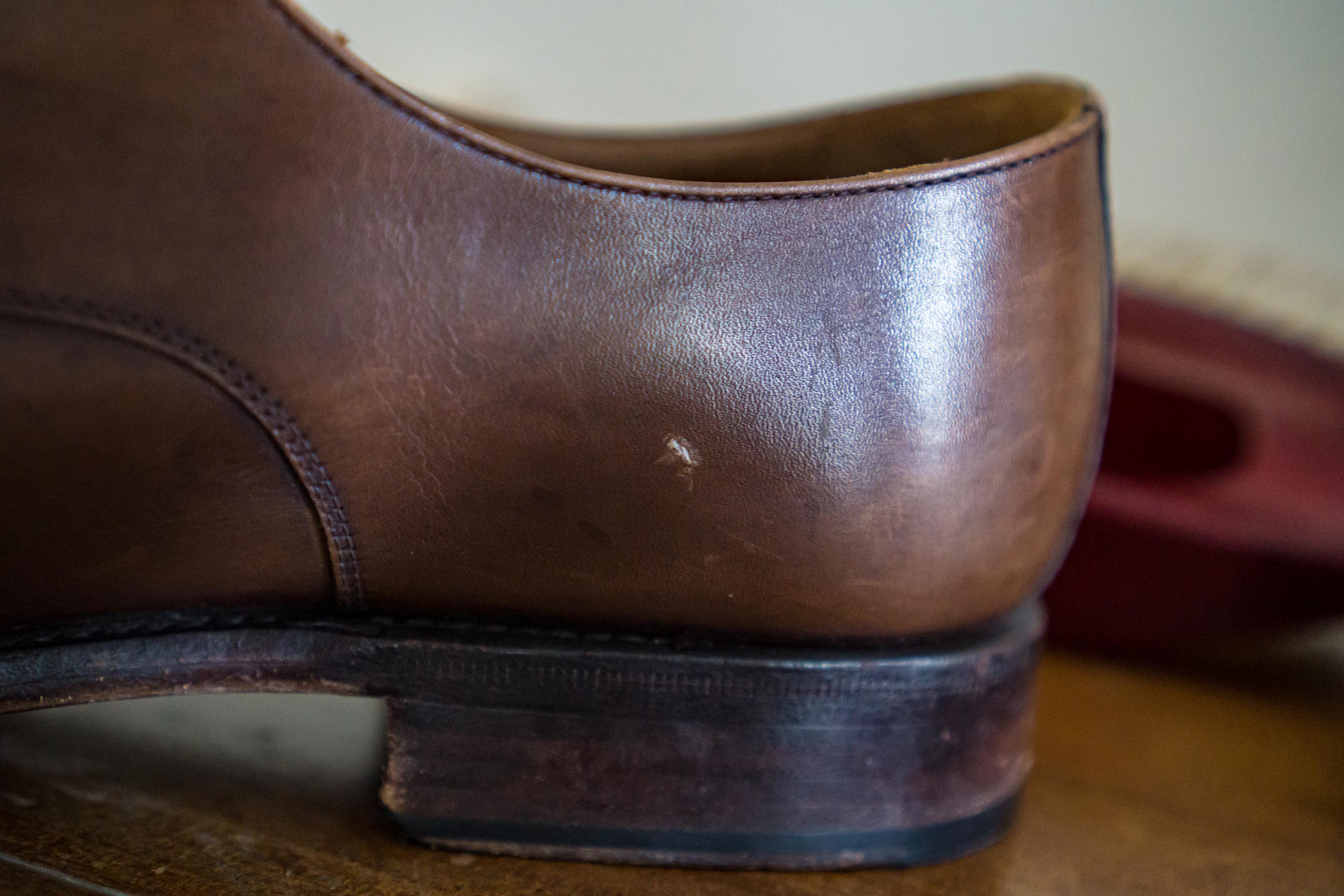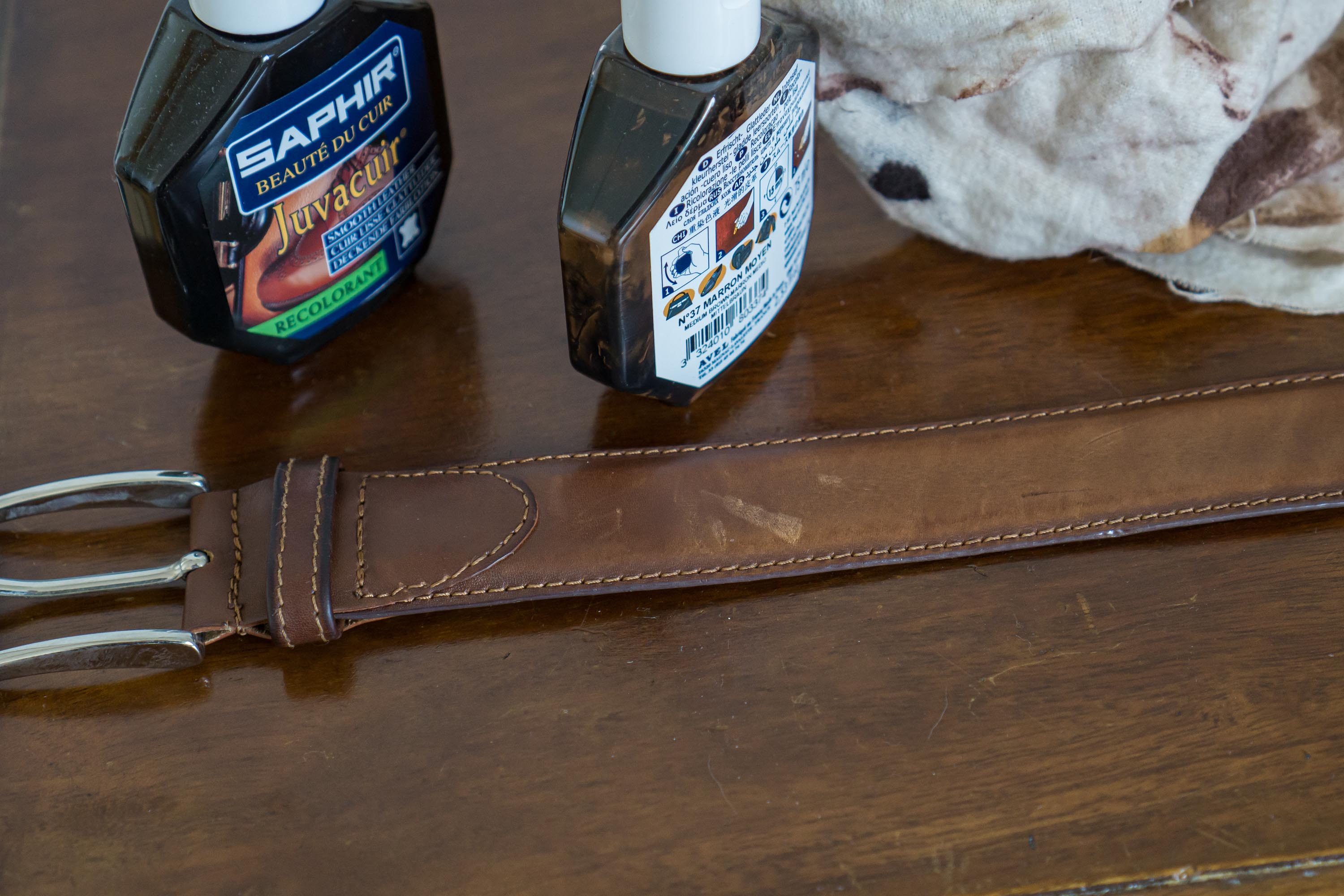
In this guide, we go through several different types of colouring of leather, ranging from covering small, deep tears in the leather, to completely re-dying a pair of shoes or a bag. For different types of dyeing of leather, different types of techniques and different products are required, here we give a good overview.
We will go through the following different types of colouring of leather in this guide:
- Cover a tear in the leather
- Cover smaller marks and regain color on leather shoes
- Cover marks and regain color on leather products
- Cover smaller marks and regain color on suede and nubuck
- Recolour smooth leather
We mainly use products from the world-famous shoe and leather care brand Saphir. To find the right color, we recommend that you check out our Saphir colour guide.
Cover a tear in the leather
Unfortunately, a common damage to both leather shoes and various leather products, such as bags, belts, wallets and so on, is that you happen to get a deep tear in the skin. As many leather products are made of chrome-tanned leather, its gray-blue core becomes visible, which makes the tear extra obvious. The problem with this type of damage is not only that it can look dull, but also that the leather here becomes more sensitive, as it's not protected by the outer grain part which is most resistant.

A tear in the leather on a shoe, where the lighter core is visible.
Saphir Renovating Cream is a paste developed to cover this type of tear. Choose a shade as close to the color of the leather as possible, here it's extra important to match well as the paste itself should colour over the tear, and on leather that is not very close in shade you ideally should mix different Renovating Cream colours to get as close as possible.
Make sure the area to be repaired is clean, and if loose pieces of skin protrude or are notched, try to make the tear as "clean" as you can. Take a very small amount of Saphir Renovating Cream on a cloth (if the tear is small, you can fold the cloth to get like a small tip, which you apply the cream with), or use a finger. Try to get an even surface over the tear, and then wipe off excess around the tear immediately with a clean surface on the cloth. The repair should look as neat as possible, it's before the product dries that you have the opportunity to fix it and rather redo and try again if it gets sloppy. When you are happy with how you covered the tear, let it dry for 15 minutes, preferably half an hour. Check what it looks like, and improve if necessary, let it dry for 15-30 minutes again. Then you can brush the surface with a clean part of the cloth with a light hand. If it's shoes, you can polish area with Saphir Medaille d'Or Pommadier shoe cream afterwards, but note that the cream will not adhere in the same way to the repaired surface as on the leather itself.
Shape the cloth to be able to apply a small amount solely on the tear.
Definitely better afterwards. Less visible, and not least better protected.
Cover smaller marks and regain color on leather shoes
This is probably the part of this guide that is best known and most executed. That with a well-pigmented shoe cream you can cover over smaller marks and regain much of the color of leather shoes. We recommend Saphir Medaille d'Or Crème Pommadier, which contains a lot of pigment. It's a shoe cream that is very ample, so use small amounts and apply a thin layer over the shoe, either with a cloth or an application brush. Also use the brush in the area between the upper and the sole edge, and don't forget the sole and heel edge itself, which is also made of leather and do good from care and new colour.
To really shoe the difference pigmented shoe cream can do we here polish up a pair of well worn children shoes. They have a sole edge in lighter colour, hence it's covered with masking tape.
Let the shoe rest for 5-10 minutes and brush off excess and bring out the shine with a shoe brush with horsehair. If the shoes have a lot of marks, you can add 1-2 more layers according to the same procedure. If a higher shine is desired, continue with Saphir Pate de Luxe wax polish, which also adds additional protection
Before and after.
Read more about how to polish your shoes and get in-depth tips in our shoe care guide. The shoe polish is very caring and adapted to give maximum care to severely exposed shoes, however, it can discolour a little if it is used on leather products that are in contact with clothing, such as bags, belts or the like. To regain color on that type of product, we recommend Saphir Juvacuir recolouring cream (more about this below), it can also be used on shoes if you need another bit of a colour boost where the pigmented shoe cream is not enough.
Cover marks and regain colour on leather products
Most leather products get marks and lose their color over time, but it's also possible to restore these so that they look fantastic again. Saphir Juvacuir recolouring cream is a re-pigmenting cream used to recolouring smooth or embossed leather. Works excellent on all types of smooth full grain leather products, like shoes, briefcases, bags, jackets, wallets, furnitures, saddles, belts, and so on. It contains natural beeswax and vegetable waxes to provide total nourishment and protection, yet will not rub off or be removed when wet.
Juvacuir is not used to change the colour (for that we have Saphir Teinture Francais leather dye, more about that below), but to give colour back to leather products that have become faded and dull, or have had scratches or similar where it's been removed. A bit of a miracle product, which can make really beaten leather goods look like new again.
Belt which has lost colour and have some marks.
Before applying Saphir Juvacuir recolouring cream, make sure that the leather is clean and has no dirt residue. It's best to use Saphir Renomat or Saphir Leather Cleanser. If the leather is dry, you may need to moisturise it before applying Juvacuir, otherwise it will not go into the leather. Moisturise with Saphir Leather Lotion or Saphir Dubbin Graisse conditioner.
When applying Saphir Juvacuir, apply a small amount of cream to a cotton cloth and rub it gently in circular motions on the area you want to color. Let dry for about 15 minutes before going over it with a dry part of the cloth. Repeat if necessary. On leather products that are in contact with clothes and therefore can discolour, you can use Saphir Stop Color to be extra sure to avoid color coming off.
Application of Juvacuir.
As new again afterwards.
If it's shoes you have used it on, it's recommended that you use Saphir Medaille d'Or Crème Pommadier shoe cream and maybe also Saphir Pate de Lux wax polish afterwards (more on covering smaller marks and regaining the color of leather shoes above).
Cover smaller marks and regain color on suede and nubuck
Also for suede and nubuck, it's possible to recolour the material and cover marks. It's made with pigmented Saphir Medaille d'Or Renovateur spray, which both cleans, nourish and re-colours your suede or nubuck and makes it like new again, also making them waterproof. The spray does not contain any silicone and is very concentrated.
Best is to spray Saphir Medaille d'Or Renovateur spray on shoes or leather products that are relatively clean. If they are very dirty, wash them first with a mild cleaner like Saphir Omninettoyant and make sure they dry properly. The suede is then brushed with a good suede brush which lifts the fibres. If the shoes/leather products are more moderately dirty you only do the step with the suede brush and get rid of the dirt with that.
Suede shoes before and after a cleaning and spray with coloured Saphir Renovateur.
Spray evenly over the entire shoe from about 20 cm distance. Suede Renovateur is highly concentrated, so one layer around the shoe is enough. This is done outside. For shoes, cover areas that you don't want to be recoloured, like the sole edge if thats in another shade compared to the shoe etc. For leather products, in general we recommend neutral spray and to avoid pigmented spray, since it can come off on clothing etc. After 10-15 minutes you can go over the suede gently with the suede brush, or use a regular shoe brush with horsehair. For the best protection it's recommended to complement with Saphir Medaille d'Or Super Invulner waterproofing spray. You now have a very good protection against water and dirt that goes deeper into the material.
See here for a more thorough guide going through a full refurbishment of a pair of suede shoes.
Recolour smooth leather
For a more professional recolouring of shoes or other leather products, a real leather dye is used, such as Saphir Teinture Francaise. It's a leather color which penetrates the leather and sits permanently, and which if you are skilled can be used to create a really gorgeous patina effect on the leather product, or just a new even shade. As a rule, it' is only possible to recolour from a lighter shade to a darker one.
Shoes being recoloured.
We have a detailed guide on how to paint shoes here, which you can follow also if you just want to change from one shade to another even shade, or for other leather products, with the only addition that you should use Saphir Stop Color afterwards.
If you have more questions or concerns about shoe and leather care in general or colouring leather products in particular, please contact us at ktj@skolyx.se for further guidance.
